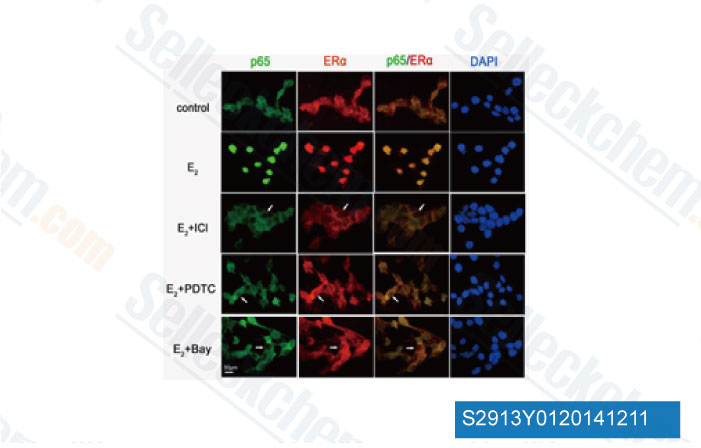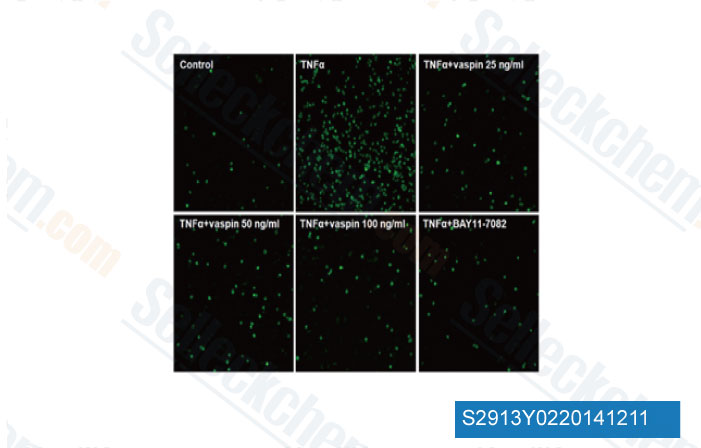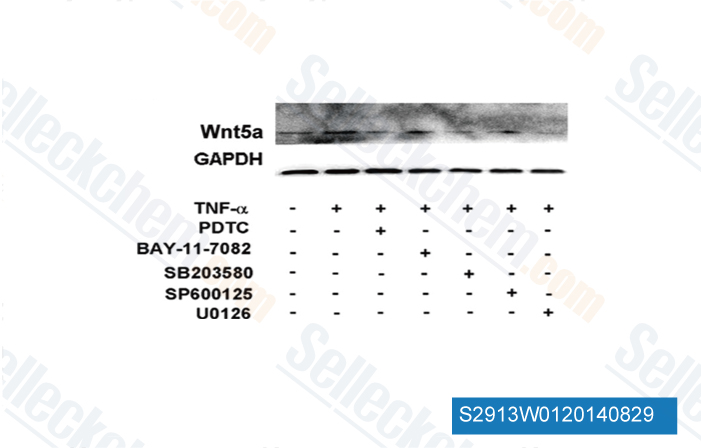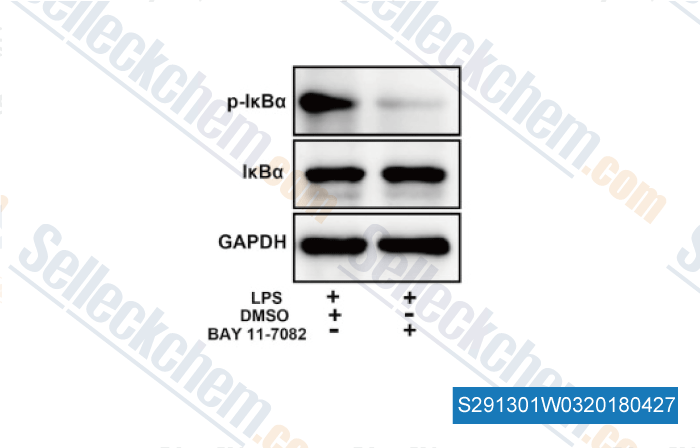|
Toll Free: (877) 796-6397 -- USA and Canada only -- |
Fax: +1-832-582-8590 Orders: +1-832-582-8158 |
Tech Support: +1-832-582-8158 Ext:3 Please provide your Order Number in the email. |
Technical Data
| Formula | C10H9NO2S |
|||
| Molecular Weight | 207.25 | CAS No. | 19542-67-7 | |
| Solubility (25°C)* | In vitro | DMSO | 41 mg/mL (197.82 mM) | |
| Ethanol | 10 mg/mL (48.25 mM) | |||
| Water | Insoluble | |||
|
* <1 mg/ml means slightly soluble or insoluble. * Please note that Selleck tests the solubility of all compounds in-house, and the actual solubility may differ slightly from published values. This is normal and is due to slight batch-to-batch variations. * Room temperature shipping (Stability testing shows this product can be shipped without any cooling measures.) |
||||
Preparing Stock Solutions
Biological Activity
| Description | BAY 11-7082 (BAY 11-7821) is a NF-κB inhibitor, inhibits TNFα-induced IκBα phosphorylation with IC50 of 10 μM in tumor cells. BAY 11-7082 inhibits ubiquitin-specific protease USP7 and USP21 with IC50 of 0.19 μM and 0.96 μM, respectively. BAY 11-7082 induces apoptosis and S phase arrest in gastric cancer cells. | ||||||||||
|---|---|---|---|---|---|---|---|---|---|---|---|
| Targets |
|
||||||||||
| In vitro | BAY 11-7082 completely and specifically abrogates NF-κB DNA binding, downregulating the NF-κB-inducible cytokine IL-6 and inducing apoptosis. [1] BAY 11-7082 (< 8 μM) is able to effectively inhibit both basal and TNFα stimulated NFκB luciferase activity in a dose dependent manner. BAY 11-7082 (8 μM) strongly inhibits the rate of proliferation in NCI-H1703 cells. [2] Bay 11-7082 (5 μM) rapidly and efficiently reduces the DNA binding of NF-kappaB in HTLV-I-infected T-cell lines and down-regulates the expression of the antiapoptotic gene, Bcl-x(L), whereas it has little effect on the DNA binding of another transcription factor, AP-1. Bay 11-7082-induced apoptosis of primary ATL cells is more prominent than that of normal peripheral blood mononuclear cells, and apoptosis of these cells is also associated with down-regulation of NF-kappaB activity. Bay 11-7082 (5 μM) selectively induces apoptosis of HTLV-I–infected T-cell lines associated with down-regulation of the expression of cyclin D1, cyclin D2, and Bcl-xL. [3] BAY 11-7082 (100 μM) prevents the nuclear translocation of p65 elicited by NMDA and the NMDA-induced increase of NF-κB binding in mouse hippocampal slices. BAY 11-7082 prevents NMDA toxicity occurring in CA1 region of hippocampal slices with 40% neuroprotection at 20 μM and 70% neuroprotection at 100 μM. [4] BAY 11-7082 at all concentrations tested significantly inhibits NF-κB p65 DNA-binding activity in adipose tissue, whereas in skeletal muscle, BAY 11-7082 at 50 μM and 100 μM significantly inhibits NF-κB p65 DNA-binding activity. BAY 11-7082 (100 μM) reduces IKK-β protein in human adipose tissue and skeletal muscle. BAY 11-7082 (100 μM) significantly decreases the release of TNF-α from adipose tissue, whereas the release of IL-6 and IL-8 is significantly inhibited at all concentrations of BAY 11-7082 tested. BAY 11-7082 (50 μM) significantly decreases the release of TNF-α, IL-6, and IL-8 in skeletal muscle. [5] BAY 11-7082 is also found to inactivate the E2-conjugating enzymes Ubc (ubiquitin conjugating) 13 and UbcH7 and the E3 ligase LUBAC (linear ubiquitin assembly complex), and thus induces B-cell lymphoma and leukaemic T-cell death. [6] |
||||||||||
| In vivo | BAY 11-7082, an NF-κB inhibitor, induces apoptosis and S phase arrest in gastric cancer cells. |
Protocol (from reference)
| Cell Assay: |
|
|---|---|
| Animal Study: |
|
References
Customer Product Validation

-
Data from [Data independently produced by Int J Cancer, 2014, 135(2), 282-94]

-
Data from [Data independently produced by Cardiovasc Diabetol, 2014, 13, 41]

-
Data from [J Biol Chem, 2014, 289(30), 21028-21039]

-
Data from [Data independently produced by , , Cancer Lett, 2016, 378(2):131-41]
Selleck's BAY 11-7082 has been cited by 394 publications
| PDPN+ cancer-associated fibroblasts enhance gastric cancer angiogenesis via AKT/NF-κB activation and the CCL2-ACKR1 axis [ MedComm (2020), 2025, 6(1):e70037] | PubMed: 39764562 |
| Helicobacter Pylori-induced BRD2 m6A modification sensitizes gastric cancer cells to chemotherapy by breaking FLIP/Caspase-8 homeostasis [ Int J Biol Sci, 2025, 21(1):346-362] | PubMed: 39744419 |
| The balance between IFN-γ and ERK/MAPK signaling activities ensures lifelong maintenance of intestinal stem cells [ Cell Rep, 2025, S2211-1247(25)00057-9] | PubMed: 39952238 |
| Superoxide dismutase promotes gastric tumorigenesis mediated by Helicobacter pylori and enhances resistance to 5-fluorouracil in gastric cancer [ iScience, 2025, 28(2):111553] | PubMed: 39898027 |
| Opposing effects of mycotoxins alternariol and deoxynivalenol on the immunomodulatory effects of oxaliplatin and triapine [ Toxicology, 2025, 511:154039] | PubMed: 39725263 |
| The efficacy of chemotherapy is limited by intratumoral senescent cells expressing PD-L2 [ Nat Cancer, 2024, 10.1038/s43018-023-00712-x] | PubMed: 38267628 |
| IL33-induced neutrophil extracellular traps (NETs) mediate a positive feedback loop for synovial inflammation and NET amplification in rheumatoid arthritis [ Exp Mol Med, 2024, 56(12):2602-2616] | PubMed: 39617790 |
| Tryptanthrin targets GSTP1 to induce senescence and increases the susceptibility to apoptosis by senolytics in liver cancer cells [ Redox Biol, 2024, 76:103323] | PubMed: 39180983 |
| Macrophage Tim-3 maintains intestinal homeostasis in DSS-induced colitis by suppressing neutrophil necroptosis [ Redox Biol, 2024, 70:103072] | PubMed: 38330550 |
| Macrophage biomimetic nanoparticle-targeted functional extracellular vesicle micro-RNAs revealed via multiomics analysis alleviate sepsis-induced acute lung injury [ J Nanobiotechnology, 2024, 22(1):362] | PubMed: 38910259 |
RETURN POLICY
Selleck Chemical’s Unconditional Return Policy ensures a smooth online shopping experience for our customers. If you are in any way unsatisfied with your purchase, you may return any item(s) within 7 days of receiving it. In the event of product quality issues, either protocol related or product related problems, you may return any item(s) within 365 days from the original purchase date. Please follow the instructions below when returning products.
SHIPPING AND STORAGE
Selleck products are transported at room temperature. If you receive the product at room temperature, please rest assured, the Selleck Quality Inspection Department has conducted experiments to verify that the normal temperature placement of one month will not affect the biological activity of powder products. After collecting, please store the product according to the requirements described in the datasheet. Most Selleck products are stable under the recommended conditions.
NOT FOR HUMAN, VETERINARY DIAGNOSTIC OR THERAPEUTIC USE.
